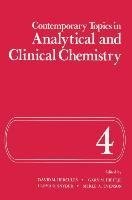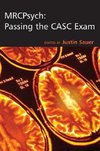
-
 Anglický jazyk
Anglický jazyk
Contemporary Topics in Analytical and Clinical Chemistry
Autor: David M. Hercules
1. Polychromatic Analysis Using the Technicon STAC¿ Analyzer.- 1. Introduction.- 2. The STAC Analyzer.- 2.1. Diluter/Dispenser Module.- 2.2. Analytical Module.- 2.3. Electronics Module.- 3. General Theory.- 4. Selection of Primary and Secondary Wavelengths.-... Viac o knihe
Na objednávku, dodanie 2-4 týždne
49.49 €
bežná cena: 54.99 €
O knihe
1. Polychromatic Analysis Using the Technicon STAC¿ Analyzer.- 1. Introduction.- 2. The STAC Analyzer.- 2.1. Diluter/Dispenser Module.- 2.2. Analytical Module.- 2.3. Electronics Module.- 3. General Theory.- 4. Selection of Primary and Secondary Wavelengths.- 5. Classification of Polychromatic Analysis.- 5.1. Correction for Nonreactive (Static or Time Invariant Interferences).- 5.2. Correction for Reactive (Kinetic) Interferences.- 5.3. Correction for a Combination of Both Reactive and Nonreactive Interferences.- 5.4. Detection of Substrate Depletion.- 6. STAC Assays.- 7. Examples of Polychromatic Analysis.- 7.1. Calcium.- 7.2. Total Bilirubin.- 7.3. Uric Acid.- 7.4. Triglycerides.- 7.5. AST.- 8. Conclusion.- References.- 2. Introduction to Multiple-Wavelength Spectrophotometric Measurements in Analytical and Clinical Chemistry.- 1. Introduction.- 2. Definitions.- 3. Applications in Analytical Chemistry.- 4. Applications in Clinical Chemistry.- 5. Epilogue.- References.- 3. Bichromatic Analysis: The Design and Function of the ABA-100.- 1. Introduction.- 2. Design Principles.- 3. Performance of Individual Instrument Functions.- 3.1. Photometric Uncertainty and Linearity.- 3.2. Control of Reaction Temperature.- 3.3. Sample Evaporation.- 3.4. Volume Measurement.- 3.5. Performance Characteristics Unique to Bichromatic Measurements.- 4. Automation of a Specific Method with the ABA.- 5. Quality Control.- 6. Special Applications.- 7. Epilogue.- References.- 4. Bichromatic Analysis as Performed in the Du Pont Automatic Clinical Analyzer (¿aca¿).- 1. Introduction.- 2. Analytical Test Pack.- 2.1. Header.- 2.2. Pack Envelope.- 3. Instrument.- 3.1. Sample Handling/Pack Filling.- 3.2. Timing, Temperature, Reagent Addition/Mixing, and Incubation.- 4. Measurement System.- 4.1. Measurement Techniques.- 4.2. Electro-Optical System Description.- 4.3. Zero Absorbance Requirement.- 4.4. Output Result Performance and Calibration.- 5. Measurement Principles.- 5.1. Implementation.- 5.2. Representative Examples.- 5.3. Reaction Time Courses.- 5.4. Chromophore Spectra.- 5.5. Performance.- 6. Advantages.- 6.1. Disadvantages.- 6.2. Future Applications.- References.- 5. The Analysis of Matrix Formatted Multicomponent Data.- 1. Introduction.- 1.1. Data Reduction Strategies in Analytical Chemistry.- 1.2. Description of MFMDT.- 2. Linear Algebra Review.- 2.1. Vectors and Matrices.- 2.2. Arithmetic of Matrices.- 2.3. Matrix Solution of a System of Linear Equations.- 2.4. Basis and Rank.- 2.5. Identity and Inverse Matrices.- 2.6. Eigenvalues and Eigenvectors.- 2.7. Glossary.- 3. Theory and Application of MFMDT in Qualitative Analysis of the Fluorescence Emission-Excitation Matrix (FEEM).- 3.1. Properties of Fluorescence Emission.- 3.2. Principles of Qualitative Analysis of the FEEM by MFMDT.- 3.3. Qualitative Analysis of Simulated Fluorescence Data.- 3.4. Qualitative Analysis of Experimental Fluorescence Data.- 4. Theory and Application of MFMDT in Quantitative Analysis of the FEEM.- 4.1. Theory of Least Squares Analysis of the FEEM.- 4.2. Theory of Linear Programming Analyses (Simplex Method) of the FEEM.- 4.3. Quantitative Analysis of Simulated Fluorescence Data.- 4.4. Quantitative Analysis of Experimental Fluorescence Data.- 5. Summary and Conclusion.- 5.1. Effectiveness of MFMDT for Analysis of Multicomponent Fluorescence Data.- 5.2. Expansion and Future Applications of MFMDT.- 6. Appendices.- 6.1. Fortran Subroutines for Qualitative Analysis.- 6.2. Fortran Subroutines for Quantitative Analysis.- References.- 6. Nonlinear Parameter Estimation of Convolved Excitation and Multiple Emission Response Functions.- 1. Introduction.- 1.1. Luminescence Processes.- 1.2. Modern Instrumentation.- 1.3. Algorithms for Nonlinear Data Analysis.- 2. Instrumentation and Analytical Parameters.- 2.1. Time Correlated Single-Photon Method.- 2.2. Theory.- 2.3. Pile-Up.- 2.4. Time-to-Amplitude Converter.- 2.5. Excitation Source.- 2.6. Optics.- 2.7. Photomultiplier Tube.- 2.8. Start and Stop Lines.- 2.9. Timing Filter Amplifier (TFA).- 2.10. Analytical Considerations¿ Intensity versus Concentration.- 2.11. Scattered Excitation Radiation.- 2.12. Analytical Wavelength and Bandpass Selection.- 2.13. Linearity versus Concentration.- 3. Data Handling.- 3.1. Theory and Description of the Algorithms.- 3.2. Grid Search Algorithms (GSA).- 3.3. Moments Algorithm (MA).- 3.4. Marquardt¿s Algorithm (MQA).- 4. Experimental.- 4.1. Data Sources.- 5. Results and Discussion.- 5.1. Simulated Data¿GSA.- 5.2. Simulated Data¿MA.- 5.3. Simulated Data¿MQA.- 5.4. Comparison of Convergence Characteristics for MQA and MA.- 5.5. Convergence Rate and Efficiency.- 5.6. Fluorescence Data.- 6. Summary.- References.- 7. ESCA Studies of Electrode Surfaces.- 1. Introduction.- 2. Electrode Transfer.- 2.1. The Possibilities for Film Change and Decomposition During Transfer.- 2.2. The Anaerobic Transfer Electrochemical Cell.- 3. Data Analysis.- 4. Carbon and Related Electrodes.- 5. Electrodes Involving Magnesium and Aluminum.- 5.1. Detection of Precipitation of Magnesium Hydroxide.- 5.2. Effect of Ions on the Anodic Oxide Films on Aluminum.- 5.3. Anodization of Aluminum in Liquid Hydrogen Fluoride.- 6. Electrodes Involving Titanium.- 6.1. Titanium Metal and Alloys.- 6.2. Titanium Dioxide and Related Electrodes.- 7. Vanadium Pentoxide Electrodes in Reserve Cells.- 8. Electrodes Involving Chromium.- 9. The Manganese Dioxide Electrode.- 10. Electrodes Involving Iron.- 10.1. Studies of Metallic Iron.- 10.2. Studies of Iron Alloys.- 10.3. Studies of Stainless Steel.- 11. Electrodes Involving Nickel.- 11.1. Studies of Nickel Metal.- 11.2. Studies of Molten Salt Systems.- 11.3. Studies of Nickel Alloys.- 12. Electrodes Involving Copper.- 12.1. Cu(I) Oxide Solar Cells.- 12.2. Corrosion Inhibition of Copper.- 12.3. Studies of Copper Alloys.- 13. Electrodes Involving Zinc.- 14. The Niobium Electrode.- 15. The Molybdenum Electrode.- 16. Ruthenium Dioxide-Based Film Electrodes.- 17. Electrodes Involving Tantalum.- 18. Electrodes Involving Tungsten.- 19. Electrodes Involving Tin.- 19.1. Studies of Oxidized Tin Surfaces.- 19.2. Studies of the Anodic Polarization of Metallic Tin.- 19.3. Studies of Tinplate.- 19.4. Studies of Tin Alloys.- 20. The Study of Anodic Oxide Films on Gallium Arsenide and Related Compounds.- 21. Chemically Modified Electrodes.- 21.1. Modified Electrodes.- 21.2. Modified Electrodes with Covalently Bonded Species.- 22. Studies of Solid Electrolytes.- 23. Ion-Selective Electrodes.- 24. Noble Metal Electrodes.- 24.1. Studies of Oxide Films on Platinum Electrodes.- 24.2. Studies of Sulfide Films on Platinum Electrodes.- 24.3. Studies of Platinum Electrodes in Molten Salt Systems.- 24.4. Electro-Oxidation in Platinum Systems.- 24.5. Underpotential Deposition on Platinum Electrodes.- 24.6. Studies of Lead Oxidation on a Platinum Electrode.- 24.7. Studies of Oxide Films on Gold Electrodes.- 24.8. Studies of Oxide Films on Palladium Electrodes.- 24.9. Studies of Oxide Films on Iridium Electrodes.- 24.10. Studies of Mixed Noble Metal Systems.- 25. Trace Metal Analysis.- 26. Studies of Paint Films.- 27. AES Studies of Electrode Surfaces.- 28. Conclusion.- References.- 8. Spatially Resolved Spectroscopy: Theory and Applications of the Abel Inversion.- 1. Introduction.- 2. Fundamentals.- 3. Computation of Area Matrices.- 4. Abel Inversion of Strictly Emitting Profiles.- 5. Self-Absorption and the Abel Inversion¿Theory.- 6. Self-Absorption and the Abel Inversion¿Examples.- 7. Background Correction in the Presence of Self-Absorption.- 8. Instrumental Misalignment and Spark Wander.- 9. Summary on Wander.- 10. True Measurement Noise.- 11. Spatially Unseparated Emission and Absorption.- 12. Conclusion.- 13. Appendix.- References.
- Vydavateľstvo: Springer US
- Rok vydania: 2013
- Formát: Paperback
- Rozmer: 229 x 152 mm
- Jazyk: Anglický jazyk
- ISBN: 9781461334200












